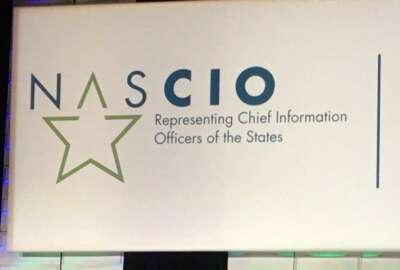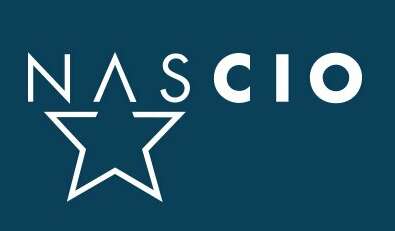
NASCIO executive director reflects on election impact, spring 2020 conference
While the election appears to have impacted fewer state CIOs, the National Association of State Chief Information Officers’ membership continues its “churn�...
While the 2020 election appears to have potentially impacted far fewer state CIOs than in past years, the National Association of State Chief Information Officers’ (NASCIO) state CIO membership continues its “churn” as executive director Doug Robinson calls it in our interview this week on Federal News Radio, part of Federal News Network. “We have two states, Montana and Utah, that will both have new governors, as the incumbents were term limited. And we will certainly have a new CIO in Montana, because current CIO Tim Bottenfield has already announced his retirement at the end of the calendar year. So he’ll be leaving before the new governor comes on board.”
As for Utah CIO Mike Hussey, that’s unpredictable. Lt. Governor Spencer Cox is the new Governor, and a Republican like his predecessor, so no party flip. “It’s still to be determined what Mike’s situation is going to be and I’m not sure that he has any indication yet. The track record in Utah is to generally have a fairly long tenure, 10 years for their state CIOs unless something happens. Obviously, my hope is that Mike stays if he wishes to.”
State CIOs fortunes unpredictable
Robinson insists that he stopped long ago trying to predict the future on these matters “because you just never know what’s going to happen.” That includes the status of the incumbent CIOs. “There’s nothing to say, and I’ve seen this happen in the past, that come January, Governors make a decision after three or four years that they want a new CIO. So they may ask their CIO to not come back for whatever reason.”
Also it’s not unusual for the incumbent CIO to decide to move on as well. “They had said to the Governor that I will serve your first term, and I will help you get reelected. And then once that happens, I am out the door. Many of them have kept to that commitment, and they will leave at the end of the year,” Robinson said.
2018 election a bloodbath for state CIOs
Still, this election is a far cry from the Tuesday night massacre of two years ago that eventually led to 25 new CIOs appointed in transitions. “Plus, during 2019 and 2020 we’ve had 15 new CIOs as well. So 40 CIO transitions in the last two years. We have a healthy, healthy churn. I always kind of joke and say the one thing that NASCIO saves a lot of association money on is longevity awards, so we don’t give out too many.”
Impact of presidential election
Our conversation shifted to the impact of the presidential election on state IT and NASCIO’s 2021 plans. “After the presidential election of 2016, we released two documents. One was, since we were going into a new administration, we released policy papers for the new administration,” said Robinson. These papers are available on NASCIO’s web site where NASCIO outlined the role of the states and top IT priorities. “Not long after that, we released a policy paper early in the second week in January, which we’ve done for the last several years, where we talk about the NASCIO’s federal advocacy priorities for the year. So we’ll be doing that again.”
NASCIO’s previous position papers in recent years focused not surprisingly on the cybersecurity front and also around the need for harmonization of regulations between federal cybersecurity rules and the states’ own guidelines. “Unfortunately, we haven’t seen substantial or substantive progress on that since we raised it several years ago.” Robinson was however pleased with the progress in the relationship with the Department of Homeland Security and their focus on cybersecurity cooperation with state and local governments. “Plus, we had a very good relationship with Suzette Kent, the former federal CIO, whom I was just on a panel with a couple of weeks ago, so we maintained a good relationship with her and met with her several times during our visits to D.C.” Robinson hopes to have a similar relationship with the new federal CIO under the Biden administration.
Robinson conceded that NASCIO didn’t have any substantial or major policy progress during the last four years. “However, I would say our major platform of cybersecurity continues to get a lot of attention, and the pandemic impact has actually brought more of that to the forefront, particularly around legacy modernization, around broadband and around cybersecurity. So that has raised the stakes on a number of those topics with the administration currently and also with a number of congressional committees that have jurisdiction in those areas.”
Robinson says that NASCIO will be doing the same thing coming up for the new administration, preparing essentially a policy white paper, as many associations do, outlining its principal interests and concerns.
Pandemic impact on NASCIO conferences past and future
As 2020 draws to a close, we reflected on the pandemic’s impact on NASCIO conferences as both the spring mid-year and fall annual events had to be done virtually for the first time. “We’re scheduled to be back at National Harbor in May of 2021. And we will be looking at that and obviously making decisions in early 2021,” Robinson said.
Given what Robinson is seeing in the conference marketplace with other major groups and associations, a spring return to NASCIO’s traditional in person format is uncertain. “It’s definitely not forgotten that we’d like to do an in person event, but it’s difficult to speculate now on what that would take from a public health perspective.” He promised to keep us informed.
Copyright © 2024 Federal News Network. All rights reserved. This website is not intended for users located within the European Economic Area.
Related Stories







